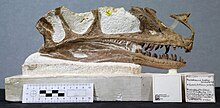Proceratosaurus
| Proceratosaurus | |
|---|---|

| |
| Holotype skull | |
| Scientific classification | |
| Domain: | Eukaryota |
| Kingdom: | Animalia |
| Phylum: | Chordata |
| Clade: | Dinosauria |
| Clade: | Saurischia |
| Clade: | Theropoda |
| Family: | †Proceratosauridae |
| Genus: | †Proceratosaurus von Huene, 1926 |
| Species: | †P. bradleyi
|
| Binomial name | |
| †Proceratosaurus bradleyi (Woodward, 1910 [originally Megalosaurus])
| |
| Synonyms | |
| |
Proceratosaurus is a
The
History of discovery
In 1910, the British paleontologist
In 1923, the German palaeontologist
Description

Proceratosaurus was a small dinosaur. In restudy at 2010, total length of 2.98–3.16 m (9.8–10.4 ft) and body mass of 28–36 kg (62–79 lb) are estimated.[1] Various books estimated it to measure 3–4 m (9.8–13.1 ft) in length and 50–100 kg (110–220 lb) in body mass.[2][3]
Classification
Arthur Smith Woodward, who initially studied Proceratosaurus, placed it as a species of Megalosaurus, due to same number of premaxillary teeth (4).[7] Later study during the 1930s by Friedrich von Huene suggested a closer relationship with Ceratosaurus, and Huene thought both dinosaurs represented members of the group Coelurosauria.[9]
It was not until the late 1980s, after Ceratosaurus had been shown to be a much more primitive theropod and not a coelurosaur, that the classification of Proceratosaurus was again re-examined. Gregory S. Paul suggested that it was a close relative of Ornitholestes, again mainly due to the crest on the nose (though the idea that Ornitholestes bore a nasal crest was later disproved). Paul considered both Proceratosaurus and Ornitholestes to be neither ceratosaurs nor coelurosaurs, but instead primitive allosauroids. Furthermore, Paul considered the much larger dinosaur Piveteausaurus to be the same genus as Proceratosaurus, making Piveteausaurus a junior synonym.[10] However, no overlapping bones between the two had yet been exposed from the rock around their fossils, and future study showed that they were indeed distinct.[1]
Several
The first major re-evaluation of Proceratosaurus and its relationships was published in 2010 by Oliver Rauhut and colleagues. Their study concluded that Proceratosaurus was in fact a coelurosaur, and moreover a tyrannosauroid, a member of the lineage leading to the giant tyrannosaurs of the Late Cretaceous. Furthermore, they found that Proceratosaurus was most closely related to the Chinese tyrannosauroid Guanlong. They named the clade containing these two dinosaurs the Proceratosauridae, defined as all theropods closer to Proceratosaurus than to Tyrannosaurus, Allosaurus, Compsognathus, Coelurus, Ornithomimus, or Deinonychus.[1][11]
Below is a cladogram from a 2022 study by Darren Naish and Andrea Cau on the genus Eotyrannus:[12]


Palaeobiology
Proceratosaurus possessed a nasal crest, which may have served as a display organ but also possibly served to reduce bending stresses on the skull when biting. This may indicate Proceratosaurus used a puncture-pull strategy for hunting prey. However, Proceratosaurus was likely not a big game hunter, lacking the bone-crushing teeth and extremely powerful bites of the tyrannosaurids. Instead, it possessed an elongated skull, commonly found in basal coelurosaurs and basal tyrannosauroids.[1]
Paleoenvironment
The flora from the roughly equivalently aged
See also
References
- ^ .
- ^ a b Holtz, Thomas R. Jr. (2008) Dinosaurs: The Most Complete, Up-to-Date Encyclopedia for Dinosaur Lovers of All Ages Supplementary Information
- ^ OCLC 985402380.
- ISBN 978-1-84028-152-1.
- ^ Holtz, Thomas (December 1998). "A new phylogeny of the carnivorous dinosaurs" (PDF). Gaia. 15: 5–61.
- ^ "Oldest T. rex relative identified". BBC News. 2009-11-04. Retrieved 2009-11-04.
- ^ S2CID 129493139.
- S2CID 131347939.
- ^ von Huene, F. (1932). "Die fossile Reptil-Ordnung Saurischia, ihre Entwicklung und Geschichte." Monographien zur Geologie und Palaeontologie (Serie 1), 4: 1–361.
- ISBN 978-0-671-61946-6.
- ^ "Oldest T. rex relative identified". 2009. Retrieved 11 November 2021.
- PMID 35821895.
- S2CID 129569932.
- .
- S2CID 55360032.
- S2CID 135409990.
- ISSN 2056-2799.
- ^ "Kirtlington 3p (Mammal Bed)". Paleobiology Database. Retrieved 28 August 2018.
